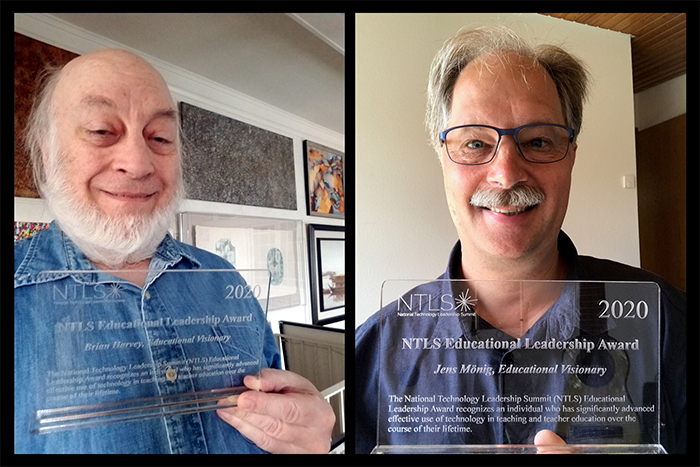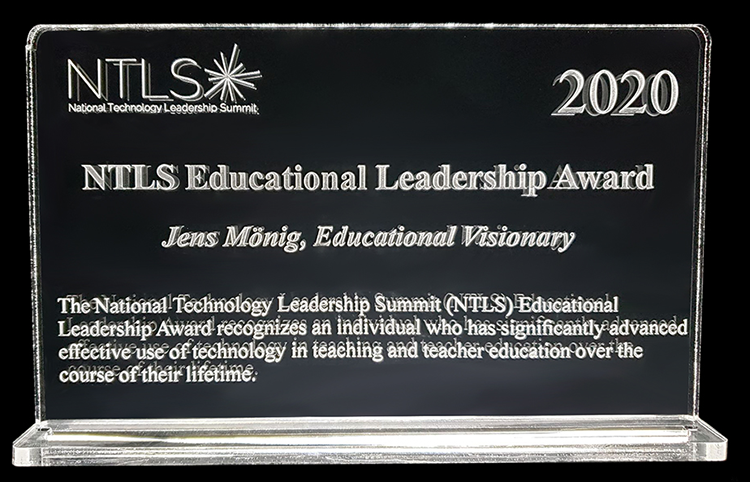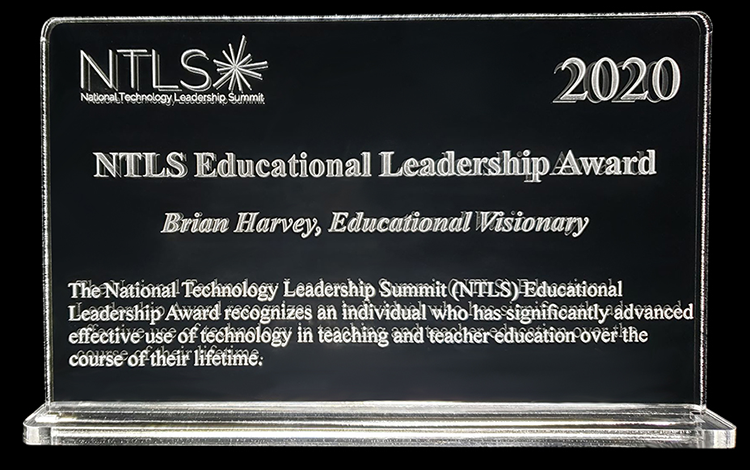Brian Harvey and Jens Moenig

The National Technology Leadership Summit (NTLS) Educational Technology Leadership Award recognizes individuals who made a significant impact on the field of educational technology over the course of a lifetime. The NTLS consortium is a coalition of twelve national teacher education associations that collaborate to advance effective use of technology in schools. The NTLS Educational Technology Leadership Award is the coalition’s highest honor.

Brian Harvey and Jens Möenig, working together, have had an impact on the field of educational technology that is as significant as any other. The origins of their work dates to development of the first computing language explicitly designed for children. In 1966 Seymour Papert, Wallace Feurzeig, Daniel Bobrow, and Cynthia Solomon created the programming language Logo. Logo, whose name is drawn from the Greek word for word, is both a technology and an educational philosophy. Its inception also resulted in the development of an educational community that exists to this day.
Brian Harvey had the opportunity to learn from Lisp inventor John McCarthy and Scheme inventors Gerald Sussman and Guy Steele, among others, as a student at the MIT and Stanford Artificial Intelligence Labs. Throughout the 1970s he was a frequent visitor at the MIT Logo Group, and starting in 1981 he was part of design teams for microcomputer versions of Logo for the Apple II, the Atari 800, and the Apple Macintosh. A high point of his career was establishing the Computer Department at the Lincoln-Sudbury Regional High School, in Massachusetts, offering ungraded courses that attracted a community of kids with keys to the lab and the responsibility for making the facility meet everyone’s needs.

In the 1980s he wrote the three-volume Computer Science Logo Style, published by MIT Press. These books showed that Logo could be used beyond elementary school to introduce serious computer science ideas to a broad and diverse audience. He subsequently taught at the University of California, Berkeley, where he was recognized with the Distinguished Teaching Award, the university’s most prestigious award for teaching. He was lead developer of Berkeley Logo, which because of its status as free software has become a de facto standard for Logo implementations. Since 2013 he has been Teaching Professor Emeritus.
On a parallel track, Jens Möenig collaborated with Alan Kay, inventor of Smalltalk, and worked with colleagues from the Xerox Palo Alto Research Center (PARC) who invented personal computing. He subsequently contributed to development of the block programming language Scratch, one of the languages influenced by Logo.
Brian Harvey and Jens Möenig then embarked upon one of the most productive collaborations in the history of educational computing, jointly developing the block programming language Snap! The Snap! reference manual notes, “The brilliant design of Scratch, from the Lifelong Kindergarten Group at the MIT Media Lab, is crucial to Snap!.”
Snap! makes advanced computational concepts accessible to nonprogrammers. Brian Harvey notes, “Languages in the Logo family, including Scratch and Snap!, take the position that we’re not in the business of training professional computer programmers. Our mission is to bring programming to the masses.” The Beauty and Joy of Computing, tightly integrated with Snap!, does just that. This curriculum, developed at the University of California at Berkeley, is notable for attracting equal numbers of male and female students.
The course is approved for Advanced Placement credit by the College Board. With support from the National Science Foundation, professional development has been provided to more than one thousand high school computer science teachers. One computer science teacher who introduced the curriculum in his high school reported that, “Before using Snap! and the Beauty and Joy of Computing curriculum, I had one section of computer science with 17 students. Three of the students were girls. Now I have three full sections of the course with equal numbers of male and female students.”
Snap!, provided as free, open source software, has inspired development of many extensions. Among others, these include environments such as Snap4Arduino, which supports work with microcontrollers and robotics; mathematics microworlds for elementary children developed by Paul Goldenberg and his colleagues at the Educational Development Corporation; and iSnap, an extension developed by Thomas Price which suggests hints to students based on the work of other students. Another extension, TuneScope, designed to facilitate exploration of coding through music, is being developed by a collaborative team at the Society for Information Technology and Teacher Education (SITE).
Snap! is a remarkable technological achievement. However, like Logo, its greatest achievement is arguably the educational philosophy that it draws upon and supports, and the associated community drawn together by this philosophy. In a very real sense, the Snap! community embodies the spirit of the early Logo community, extending it for the modern world. The NTLS Educational Technology Leadership Award, awarded to Brian Harvey and Jens Möenig, is presented in recognition of that accomplishment.
